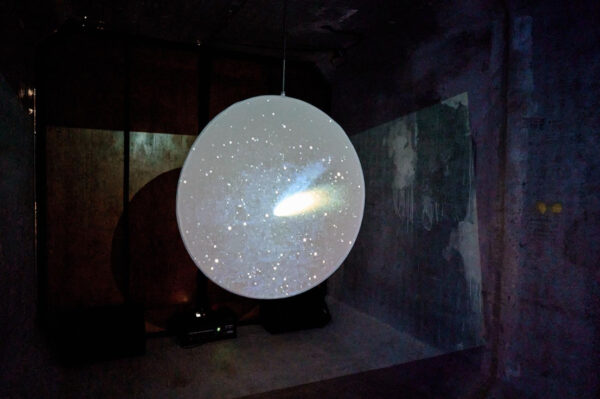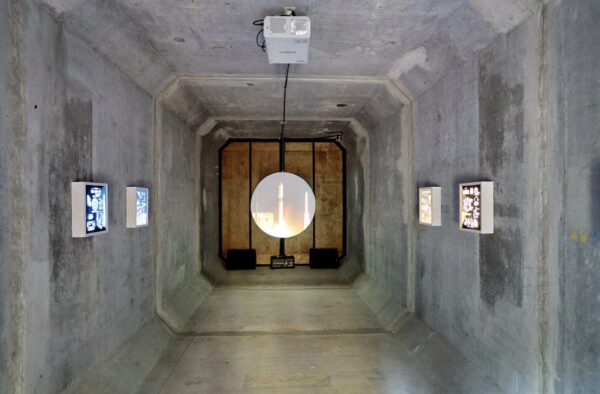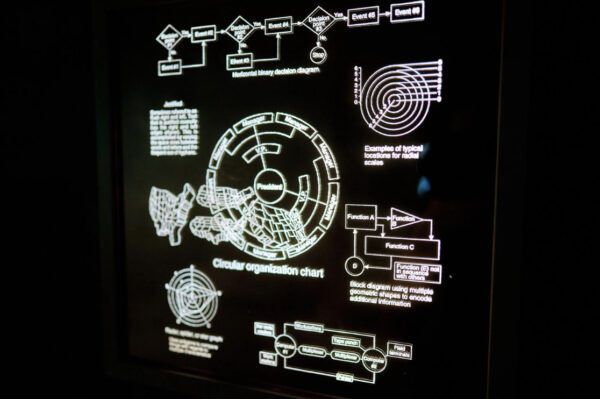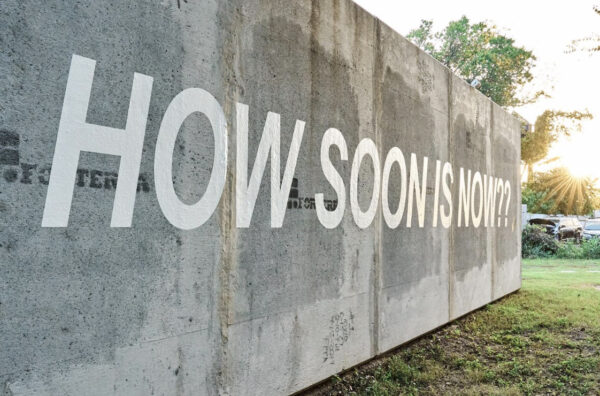Adrian Aguilera’s installation How Soon Is Now?? was on view at Co-Lab Projects in Austin, Texas from September 17 to October 29, 2022. Those who entered Co-Lab’s concrete room faced a cone-shaped screen playing found videos from twenty-five years ago — 1997. Most of the videos are recognizable to those of us old enough to remember: footage from the cloning of Dolly the sheep, or from the reporting on the Acteal massacre in Chiapas. Along the long walls, approaching the conic screen, hung lightboxes displaying business-related infographics. These were less identifiable, but they came from ‘97 too.
Despite Aguilera’s choice of found media from a specific year, no labels told visitors the dates of the videos, infographics, or songs. We had to identify such things ourselves. Or, at least, we had to read the press release, ask the artist, etc. Personal as this dating might be to Aguilera, his specificity in fact reaches toward something more general and collective. As Aguilera explained to me in the following edited interview, How Soon Is Now?? concerns the workings of memory and the ways memory connects past to present. This is about time travel.
Ariel Evans (AE): Please walk me through how the installation at Co-Lab came together.
Adrian Aguilera (AA): Originally, I conceived of the idea for untitled (apex to base: 1997) or cone-shaped screen installation for the 2020 Fusebox Festival. And then of course everything got fucked up [because of COVID-19]. I thought, “I will have another chance, a whole different time in which I will put together this idea.” The work happens to be about how I can travel to memory — time travel, at the end of the day. I divined the idea of “memory travel” because it speaks to a way of going to a specific time and moment that is in my memory.
In Chris Marker’s La Jetée (1962), the main character has one specific memory and tries to call into it. For me, [that specific memory] was when I was 16. I’ve always been thinking about returning to that time again. So, the idea about using that specific year started to develop in my thoughts.
And when I was invited to this exhibition at Co-Lab last year, I decided that the main work would be this device, this installation that allowed me to travel to a specific time. Close to the opening, I came across Henri Bergson’s representation of memory as a cone. I realized that Bergson’s cone of memory was what I was looking and thinking about in some capacity. I made this conic screen as a device for the realization of how memory works in my head.

Figure 4 in Henri Bergson’s “Of the Survival of Images. Memory and Mind. Matter and Memory,” translated by Nancy Margaret Paul and W. Scott Palmer (London: George Allen and Unwin (1911): 170-231.
AE: [Bergson explained the cone of memory like so: “If I represent by a cone SAB the totality of the recollections accumulated in my memory, the base AB, situated in the past, remains motionless, while the summit S, which indicates at all times my present, moves forward unceasingly, and unceasingly also touches the moving plane P of my actual representation of the universe. (Bergson, 196).”]
AA: The video montages these memories from 1997 together in a way that I’m able to present it and think of it as it all happens. You can see it in order, but also see it in the way one experiences memory: all these moving images come together and overlay each other. There is a blending in which everything gets to be now together.
The title comes from the Smiths’ “How Soon is Now?” from the ‘80s (1984). That song is about how quickly time passes and how fast we are here, which helped me refer to how time passes and has passed — and within a sense of present time, the now… I’m able to circle through many ideas related to memory travel, to time, and to being now.
AE: The clips projected onto the cone seem to be 1997 news items that are all science-related or science fictional. Like Dolly the cloned sheep, people thinking they are seeing UFOs, et cetera. Is there a reason for that?
AA: Not really. Most of those things are real memories that I have from that time, things that impacted me, things that I clearly remember. And coincidentally, I’m into science. I was already using computers for doing graphics — I was a graphic designer at 16.
AE: Like the infographics on the light boxes?
AA: The light boxes, yes. Those LED boxes to me are more like the sign of the devil, all these informational graphics — charts and graphs and maps — the graphical ways in which information gets represented. When I was a graphic designer, I thought that I was helping the world by putting together ideas and conveying information. But 25 years later, I’m sure that I was not doing that. This information works for capitalism, for corporations.
Playing with those infographics now — it is to use another medium to look back at and then do something with them. So, to me, the light boxes play sarcastically and ironically with how information is used in a profit-driven globalizing system.
AE: In talking about events from a while ago… did you sit down and be like, “what do I remember from that time of my life,” and then develop a list? Or do you have journals from that time that you went back and referenced?
AA: I don’t have diaries from those times. It was more like “Okay, what can I remember?” Dolly the sheep and DVD logos. The Apple ad “Think different” is another. One of the last videos is the Kyoto Protocol [an international treaty to reduce greenhouse gas emissions, signed in 1997]. There are also a bunch of ’97 social events that I pulled from, like people who were killed for political reasons. One in Mexico that I clearly remember is the [Acteal massacre].
AE: [Aguilera is referring to the murder of 45 indigenous townspeople and members of the pacifist group Las Abejas, during a prayer meeting on December 22, 1997. In 2020, the Federal Government of Mexico admitted responsibility].
AA: It was almost Christmas for us, and that event stuck in my mind. I thought “How can we celebrate Christmas when people are being killed in the south of my country?”
So, all those things get saved in my memory, in that year’s memory. And then, it was just clear to me that when I said, “Okay, what else happened to me in that year? What else happened in that year?”
AE: Given that you’re living in Monterrey in 1997, when you’re 16, is there something about the fact that you’re not just memory or time traveling but traveling across space from Monterrey to Austin. It’s both space and time travel. In other words, does your migration to the United States and to Texas also affect the installation?
AA: It’s about how I can do a spell, a spell about myself, about my own self, about… it’s funny, did you see that photo that I posted for this event, which is not anywhere else besides Co-Lab’s website promotional materials? That photo is me when I was 16. Actually, I have it — I was this woman’s replacement in that graphic design job. She was 11 years older than me. When we met, she was 27. She was very professional, but I had her same level of expertise in Photoshop at that time.
Years later, using technology, I found her online. We ended up becoming friends, then dating, then getting married. And then, we ended up moving to Austin. We were here for a few years together before we decided to get divorced. There is nothing about this that weighs on me; it’s about the history that I have had with anyone. But I kept this photo for all these 25 years, which is funny of me, I guess.
Maybe Roland Barthes’ concept of the studium and punctum are useful here.
AE: [Barthes developed the concepts of stadium and punctum in his 1980 book Camera Lucida, a meditation on the nature of photography, its connection to death, and its ability to generate emotion between viewers and photographs. Studium refers to a photograph’s cultural and political meaning, while punctum signifies a piercing and personal detail.]
AA: Barthes talks about nostalgia, about memory travel, about how one can relate to a time. But not in a particular or personal way. It’s not about my mom; it’s about everyone’s mom. It’s not about my own memory or nostalgia; it’s about nostalgia and memory that everyone experiences. It is about global occurrence.







